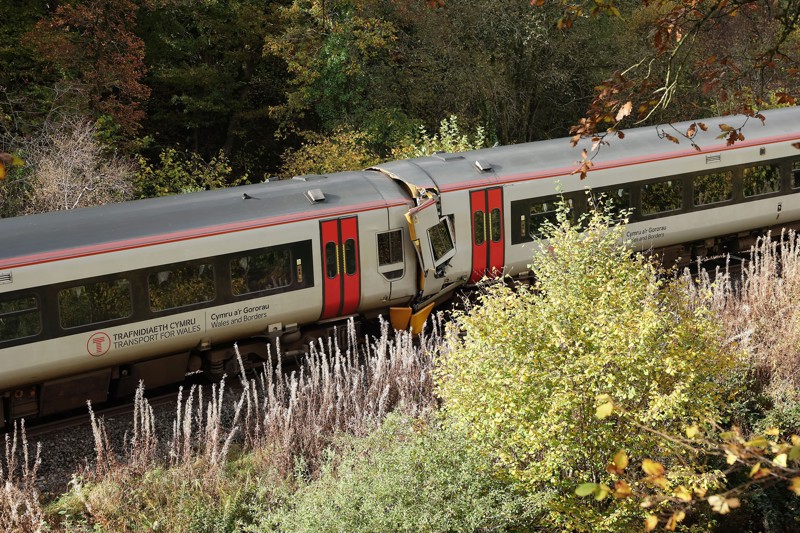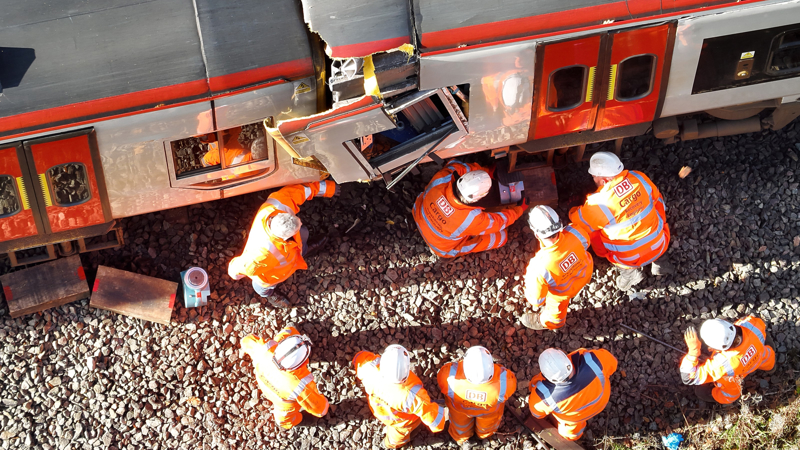
Automatic sanders on the ‘158’ that slid into an oncoming train on the Cambrian Line last month were blocked, the Rail Accident Investigation Branch (RAIB) has found.

Automatic sanders on the ‘158’ that slid into an oncoming train on the Cambrian Line last month were blocked, the Rail Accident Investigation Branch (RAIB) has found.
An initial report from investigators has discovered that the wheels on the 1831 Shrewsbury-Aberystwyth (1J25) started sliding when the driver started to brake to stop in the loop at Talerddig on Monday October 21. The slide then continued as the Class 158 headed down the 1-in-56 gradient until it collided with the 1909 Machynlleth-Shrewsbury (1S71) at 1926. Both trains were operated by Transport for Wales (TfW).
One passenger died afterwards, and four other people were seriously hurt, while 11 more needed hospital treatment for their injuries.
The report, published on Tuesday, said: “An inspection of the automatic sanding system fitted to train 1J25 after the accident showed that the sanding hoses on the leading vehicle of this train (which would have been active at the time of the accident) were blocked and apparently unable to discharge sand.”
RAIB said initial analysis of the on-train data recorder fitted to 158841, the unit heading west, showed “the driver applied service braking to slow the train as it neared the loop at Talerddig”. Westbound trains are climbing a 1-in-80 gradient as they approach the loop, which is level, before descending at 1-in-56 the other side.
The report added: “Around 40 seconds after the first service brake application, the OTDR records an emergency brake demand being made. This emergency brake demand remained in place until the collision. OTDR data shows that wheel slide started during service braking and was constant during emergency braking.”
1J25 travelled for around 800m (875 yards) until impact with 1S71.
The sanding system fitted to 158841 is automatic, discharging sand via hoses when a wheel slide is detected during braking.
RAIB inspectors have also reported “conflicting evidence relating to the speed of the trains at the point of collision”.

“Initial analysis indicates that train 1J25 was travelling at between 24 km/h (15 mph) and 39 km/h (24 mph), while train 1S71 was travelling at around 10 km/h (6 mph) in the opposite direction. RAIB is continuing to analyse evidence relating to the collision speed, which remains an area of ongoing investigation.”
Inspections of the track found wheel/rail adhesion levels at various points along the line from the approach to Talerddig loop to the collision scene were “low”.
As well as explaining the sequence of events, the full investigation will also consider:
- the actions of those involved and any factors that may have influenced them
- the level of wheel/rail adhesion present from the approach to Talerddig loop to the point of collision
- the status and performance of the braking, wheel slide protection and sanding systems on train 1J25
- the behaviour of both trains during and following the collision
- TfW’s policies relating to low wheel/rail adhesion and how it managed the risk of low adhesion on the Cambrian line
- Network Rail’s policies relating to low wheel/rail adhesion and how it managed the risk of low adhesion on the Cambrian line
- the processes used to assess and control the risk of overrun on the Cambrian line
- any relevant underlying factors, including any actions taken in response to previous relevant safety recommendations
RAIB investigators released the site back to Network Rail on Wednesday October 23 for inspections and repairs to the track, while the two TfW ‘158s’ were removed two days later.
The full report with any recommendations to improve safety will be published at the conclusion of the RAIB investigation.
In a joint statement, a spokesman for Network Rail and TfW said: “As investigations are currently still ongoing, we’ll continue to work together with investigators to understand what happened and await the full conclusion and recommendations of the investigation.
“Safety is always our main priority for our customers and colleagues, and we have carried out enhanced checks to the trains and the railway line to enable the reopening of the Cambrian line on Monday October 28.
“At this early stage of the investigation, it’s fundamental that we await the findings of the full report and show sensitivity towards our customers, colleagues, the local community and the families of those affected by the incident.”
Login to continue reading
Or register with RAIL to keep up-to-date with the latest news, insight and opinion.

















Login to comment
Comments
No comments have been made yet.